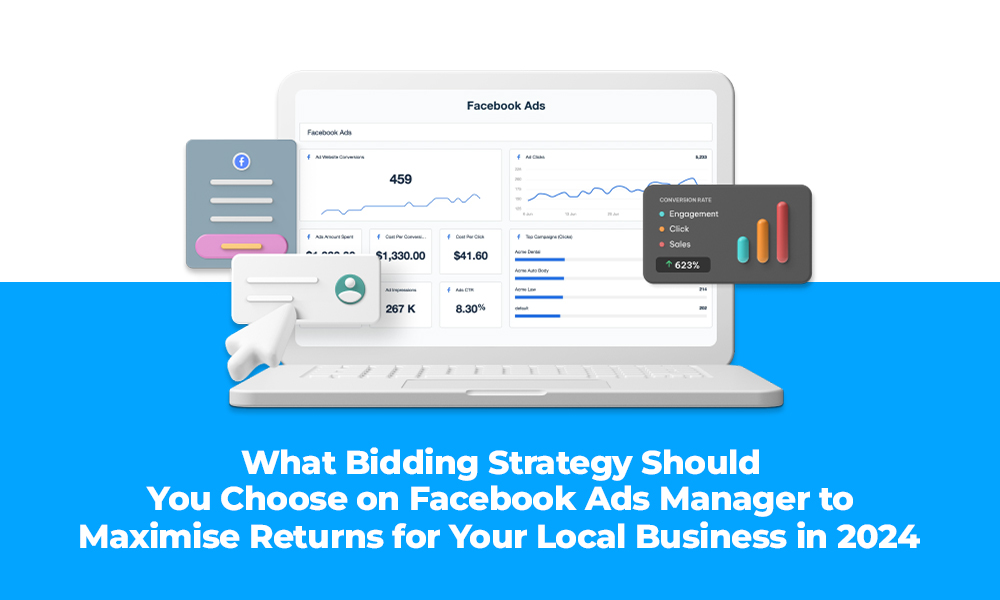Advertising on Facebook has become an indispensable tool for local businesses aiming to reach their target audience effectively. The platform offers many bidding strategies, each designed to maximise different aspects of your advertising goals. However, choosing the right Facebook bidding strategy can be a daunting task. With the right approach, you can maximise returns, optimise your ad spend, and ensure that your marketing efforts translate into tangible business growth.
This comprehensive guide will delve into the intricacies of Facebook ads bid strategy, focusing on how local businesses can make the most out of their advertising budget. We will explore various bid strategies in Facebook ads, such as spend-based, goal-based, and manual bidding. Furthermore, we will discuss the importance of setting clear objectives and the factors to consider when selecting the appropriate strategy for your local business.
Setting Objectives for Your Local Business
Before diving into the specifics of Facebook’s bidding strategy, it is crucial to establish clear objectives for your advertising campaigns. Understanding what you want to achieve with your Facebook ads will guide your choice of bid strategy in Facebook ads and ensure that your efforts are aligned with your business goals. Here are some common objectives for local businesses:
- Increasing Brand Awareness: If your goal is to increase people’s awareness of your business, you might focus on reach and impressions.
- Generating Leads: Lead generation is a key objective for businesses looking to gather contact information from potential customers.
- Driving Sales: If your primary goal is to boost sales, you should focus on conversions and purchase actions.
- Engaging Customers: Businesses that aim to build a community and engage with their audience might prioritise post engagement and video views.
By setting clear objectives, you can better tailor your Facebook ads bid strategy to meet your needs and maximise returns.
Bidding Strategies on Facebook Ads Manager
Facebook Ads Manager offers a variety of bidding strategies designed to help advertisers achieve their objectives. These strategies can be broadly categorised into spend-based, goal-based, and manual bidding. Each category offers unique advantages and is suited to different campaigns and business goals.
1. Understanding Spend-Based Bidding
Spend-based bidding strategies optimise ad spending to achieve the highest possible returns. There are two primary types of spend-based bidding on Facebook Ads Manager:
Highest Volume
The Highest Volume bidding strategy aims to get the most results within your budget. This strategy is ideal for businesses that maximise reach and generate many leads or conversions. By allowing Facebook to automatically adjust bids, this strategy ensures that your ads are shown to as many people as possible within your target audience.
Highest Value
The Highest-Value bidding strategy focuses on maximising the value of conversions rather than the volume. This approach is suitable for businesses that prioritise high-value transactions, such as luxury retailers or service providers with high-margin offerings. By optimising for the highest-value conversions, you can ensure that your ad spend is directed towards the most profitable outcomes.
2. Exploring Goal-Based Bidding
Goal-based bidding strategies are designed to achieve specific objectives, such as maintaining a desired cost per result or return on ad spend (ROAS). These strategies require a clear understanding of your business goals and a willingness to monitor and adjust your campaigns.
Cost per Result Goal
The Cost-per-Result Goal bidding strategy focuses on achieving a specific cost per result, such as a cost per click (CPC) or cost per conversion. This strategy is ideal for businesses with a defined budget and a clear understanding of their desired cost metrics. By setting a cost-per-result goal, you can ensure that your ad spend remains within budget while still achieving your desired outcomes.
The cost-per-result goal of Facebook ads is crucial for local businesses aiming to maintain a strict budget while driving specific outcomes. Setting Facebook ads’ cost-per-result goal helps align the ad spend with the business’s financial capabilities, ensuring each click or conversion stays within the affordable range. Implementing a cost-per-result goal Facebook ads strategy can greatly enhance the efficiency and effectiveness of your campaigns.
ROAS Goal (Return on Ad Spend)
The ROAS Goal bidding strategy aims to achieve a specific return on ad spend, such as generating $5 in revenue for every $1 spent on ads. This approach particularly benefits e-commerce businesses and those with a direct sales focus. By optimising for ROAS, you can ensure that your advertising efforts directly contribute to your bottom line.
The ROAS goal Facebook ads strategy is essential for businesses looking to directly measure and optimise the profitability of their campaigns. Setting a clear ROAS goal for Facebook ads allows businesses to focus on high-return activities, ensuring that every pound spent translates into measurable revenue. Businesses can maximise their return on investment by continuously monitoring and adjusting Facebook ads based on ROAS goals.
3. Manual Bidding: Taking Control
For businesses that prefer a hands-on approach, Facebook ads manual bidding allows for greater control over the bidding process. Manual bidding requires a deeper understanding of your audience and campaign performance. Still, it offers the potential for more precise optimisation.
Bid Cap
The Bid Cap strategy involves setting a maximum bid amount you are willing to pay for a specific action, such as a click or conversion. This approach can help control costs and ensure your ad spend does not exceed your budget. However, careful monitoring and adjustment are required to achieve the best results.
By setting a bid cap on Facebook ads, businesses can prevent overspending and ensure their ad budget is utilised efficiently. This strategy is particularly useful in competitive markets where bid amounts can fluctuate. Implementing a bid cap in Facebook ads helps control advertising costs while striving for optimal performance.
Factors to Consider When Choosing a Bidding Strategy
Selecting the right Facebook bidding strategy requires careful consideration of various factors, including your business objectives, budget constraints, and the size and competitiveness of your target audience.
Business Objectives
Your business objectives are crucial in determining the most suitable Facebook ads bidding strategy. For example, if your goal is to increase brand awareness, a spend-based strategy like Highest Volume may be more appropriate. Conversely, a goal-based strategy like ROAS Goal might be better if you aim to maximise revenue.
Budget Constraints
Budget constraints are another critical factor to consider when choosing a bid strategy in Facebook ads. If you have a limited budget, a cost-per-result goal strategy can help ensure that your ad spend remains within budget while achieving your desired outcomes. Alternatively, a bid cap strategy can help control costs by setting a maximum bid amount for specific actions.
Managing your budget effectively with a cost-per-result goal Facebook ads strategy ensures that you get the most value out of your ad spend. This approach allows you to set clear financial parameters and achieve your marketing goals without exceeding your budget. By focusing on Facebook ads’ cost-per-result goal, you can maintain financial discipline while driving desired results.
Audience Size and Competition
The size and competitiveness of your target audience can also impact your choice of Facebook bidding strategy. In highly competitive markets, goal-based strategies like cost-per-result or ROAS goals may be more effective in achieving your objectives. In contrast, spend-based strategies like Highest Volume or Highest Value may be more suitable in less competitive markets.
A thorough analysis of your audience and competition is essential when setting a Facebook ad cost-per-result goal. Understanding the dynamics of your market helps you tailor your bid strategy in Facebook ads to achieve optimal results. You can navigate the competitive landscape more effectively by setting realistic and achievable goals, such as cost-per-revenue goal Facebook ads.
Sales
Selecting the right Facebook ads bid strategy is crucial for businesses with a direct sales focus. Goal-based strategies, such as the ROAS and cost-per-result goals, can help ensure your advertising efforts translate into tangible sales. By optimising for specific outcomes, you can maximise the return on your ad spend and drive business growth.
Implementing a ROAS goal Facebook ads strategy ensures that your ad spend directly contributes to sales and revenue growth. This approach allows businesses to measure the effectiveness of their campaigns in real time and make necessary adjustments to maximise profitability. By setting a clear ROAS goal for Facebook ads, you can ensure that every pound spent on advertising yields significant returns.
Factors to Consider When Selecting Ad Objectives
Several factors should be taken into account when selecting ad objectives to ensure that your Facebook bidding strategy aligns with your overall business goals.
Target Audience
Understanding your target audience is essential when selecting ad objectives. Different objectives may be more suitable for different segments of your audience. For example, if you target new customers, objectives like reach and brand awareness may be more appropriate. Conversely, objectives like conversions and purchase actions may be more effective if you target existing customers.
Business Goals
Your business goals should guide your choice of ad objectives. For example, if your goal is to increase sales, objectives like conversions and ROAS may be more relevant. Alternatively, if your goal is to build brand awareness, objectives like reach and impressions may be more suitable.
Aligning your business goals with a cost-per-result goal for your Facebook ads strategy ensures that your ad spend is directed towards achieving measurable outcomes. This approach helps maintain focus on key objectives and maximise the efficiency of your campaigns. Setting a cost-per-result goal for your Facebook ads can drive specific actions that contribute to your overall business success.
Budget
Budget constraints should also be considered when selecting ad objectives. Different objectives may require different levels of investment. For example, objectives like reach and brand awareness may require a larger budget to achieve significant results. Conversely, objectives like conversions and ROAS may be more cost-effective, especially with a limited budget.
Competition Analysis
Analysing your competition can provide valuable insights into which ad objectives may be most effective. By understanding what your competitors are doing and how they are achieving their goals, you can tailor your ad objectives to better compete in your market.
A detailed competition analysis can inform your Facebook ad’s cost-per-result goal and ensure that your strategies are competitive. By setting realistic goals based on market insights, you can optimise your bid strategy in Facebook ads to achieve the best possible results. Regularly reviewing and adjusting your Facebook ads’ cost-per-result goal helps you maintain a competitive edge.
Conclusion: Deciding Wisely for Maximum Returns
Choosing the right Facebook bidding strategy is crucial for maximising returns on your advertising spend. By understanding the different bid strategies in Facebook ads, such as spend-based bidding, goal-based bidding, and manual bidding, you can make informed decisions that align with your business objectives and budget constraints.
Setting clear objectives and considering business goals, budget, audience size, and competition will help you select the most suitable Facebook ads bid strategy. Whether you opt for a cost-per-result goal, a ROAS goal, or a bid cap in Facebook ads, the key is to monitor and adjust your campaigns regularly to ensure they continue delivering the desired results.
With a well-planned Facebook bidding strategy, your local business can effectively reach its target audience, optimise ad spend, and achieve meaningful growth in 2024 and beyond.
FAQs
Determining your local business’s best Facebook bidding strategy involves understanding your objectives and constraints. Start by defining your business goals, such as increasing brand awareness, generating leads, or driving sales. Next, consider your budget and the size of your target audience. Spend-based strategies like Highest Volume are great for maximising reach. In contrast, goal-based strategies like cost per result and ROAS goals are ideal for achieving specific outcomes. Manual bidding offers more control but requires careful monitoring.
Yes, you can switch between different bid strategies in Facebook ads mid-campaign. However, it is important to monitor the impact of the change closely. Switching strategies can help optimise performance if your current approach is not delivering the desired results. Analyse the data and adjust your strategy accordingly to ensure continued success.
If your chosen Facebook ads bid strategy is not yielding the desired results, consider the following steps:
- Review Your Objectives: Ensure your ad objectives align with your business goals.
- Analyse Performance Data: Examine key metrics such as cost per result, ROAS, and engagement rates to identify areas for improvement.
- Adjust Your Strategy: Consider switching to a different bidding strategy, such as moving from a spend-based to a goal-based approach.
- Optimise Your Ads: Test different ad creatives, targeting options, and placements to improve performance.
- Monitor and Adapt: Regularly review your campaign performance and make necessary adjustments to optimise results.
Following these steps, you can refine your Facebook bidding strategy and maximise returns for your local business.












